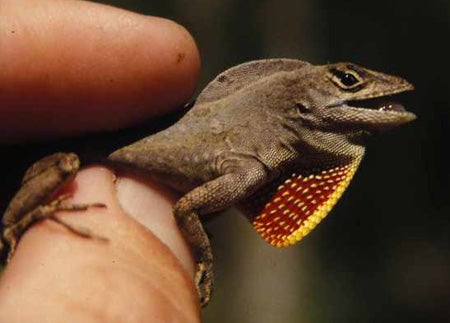SCIENTIFIC NAME:
Norops sagrei
OTHER NAME:
None
STATUS:
Exotic.
DESCRIPTION:
The brown anole is a small brown or gray lizard that may reach a total length of 9 inches. Its’ tail may be longer than the body. The brown anole may be any shade of brown, gray or black and can change color rapidly, especially if it feels threatened. Some anoles develop small yellow dots on the sides of the body when excited. The brown anole has a fairly stout body and a less elongated head than the green anole, variable markings such as dark spots, half moons, triangles, or lines running down the back, and light bands on the legs. It has slightly expanded toe-pads and a pale streak down the throat. The pale streak is a dewlap, a flap of brightly colored skin that can be extended from the neck to help protect a territory or attract a mate.
DISTRIBUTION:
The original range of the brown anole included Cuba, the Bahamas, Swan Island, Honduras, Cayman Brac, and Little Cayman. However, brown anoles have been widely introduced throughout the world with breeding populations in Florida, Texas, Louisiana and Georgia. The species has recently been reported from a few locations in extreme southern Alabama.
HABITAT:
Brown anoles are habitat generalists and can be found in practically any three-dimensional tropical or sub-tropical (year-round warm temperature and relatively high humidity) habitat type within their range. They are often found at forest edges, disturbed areas, and generally open sites. Brown anoles fall into the “trunk-ground” ecomorph, because they are usually found on the ground or on low-growing vegetation no more than a few feet off the ground. Their gray and brown coloration and pattern helps camouflage them against a backdrop of bark and dead leaves.
FEEDING HABITS:
The brown anole will often eat hatchling green anoles, a behavior that may be affecting green anole populations in the United States. In their native habitat, brown anoles eat insects, spiders, worms, snails and slugs. They are active during the day.
LIFE HISTORY AND ECOLOGY:
Brown anoles breed during the summer but begin establishing and defending territories in the spring.Female brown anoles lay one egg at atime every one to two weeks throughout the breeding season. Moist covered habitat is essential for hatchling survival during development. The eggs hatch about four weeks after being laid and the independent hatchlings grow to adult size in less than one year. The average life span of a brown anole is about 18 months but they can live up to five years in the wild.
References:
Mengak, Michael T., Associate Professor, Wildlife Specialist, Warnell School of Forestry and Natural Resources, University of Georgia.
Mirarchi, R.E., ed. 2004. Alabama wildlife. Volume 1. A checklist of vertebrates and selected invertebrates: Aquatic mollusks, fishes, amphibians, reptiles, birds, and mammals. The University of Alabama Press. Tuscaloosa, 209 pp.
Author:
Joel D. Glover, Certified Wildlife Biologist, Alabama Division of Wildlife & Freshwater Fisheries






